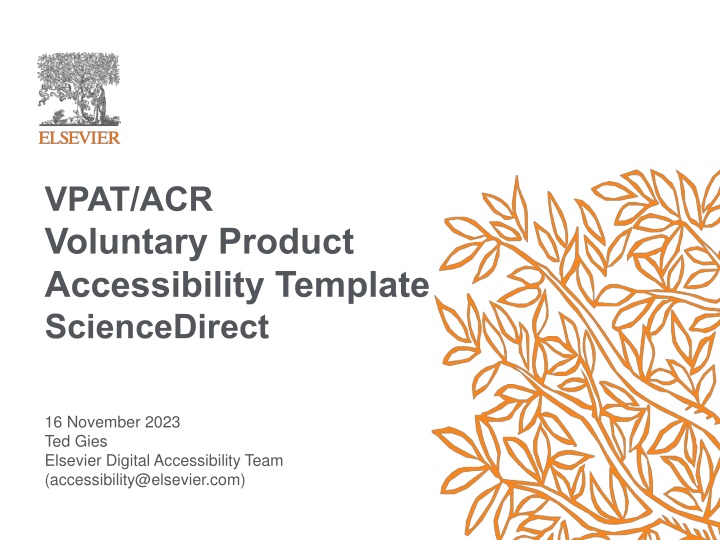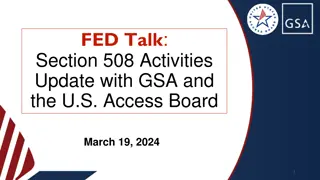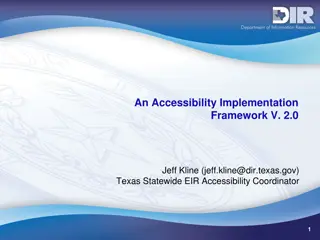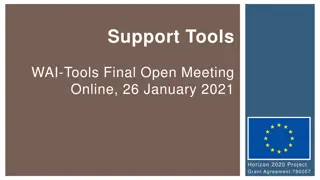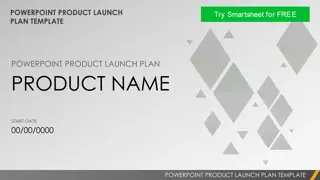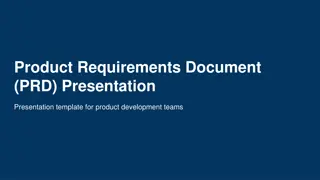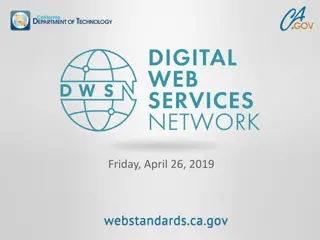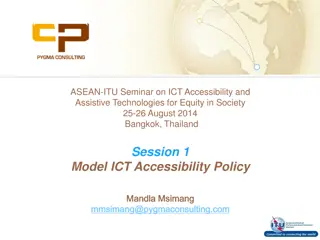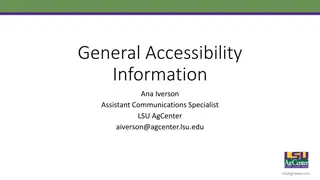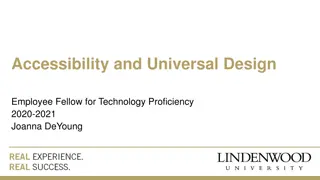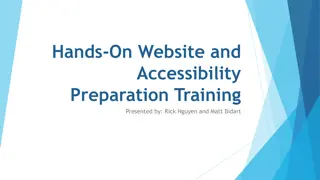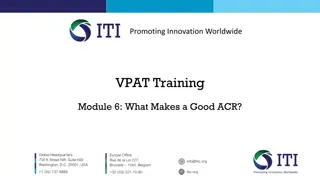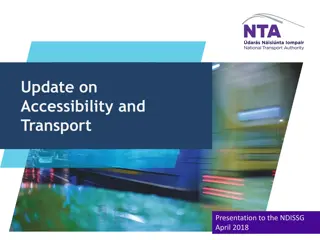VPAT/ACR Voluntary Product Accessibility Template ScienceDirect
This document provides detailed information on the voluntary product accessibility template (VPAT) for ScienceDirect, outlining conformance claims, WCAG 2.1 guidelines, version history, product information, evaluation tools, and more.
Download Presentation

Please find below an Image/Link to download the presentation.
The content on the website is provided AS IS for your information and personal use only. It may not be sold, licensed, or shared on other websites without obtaining consent from the author.If you encounter any issues during the download, it is possible that the publisher has removed the file from their server.
You are allowed to download the files provided on this website for personal or commercial use, subject to the condition that they are used lawfully. All files are the property of their respective owners.
The content on the website is provided AS IS for your information and personal use only. It may not be sold, licensed, or shared on other websites without obtaining consent from the author.
E N D
Presentation Transcript
VPAT/ACR Voluntary Product Accessibility Template ScienceDirect 16 November 2023 Ted Gies Elsevier Digital Accessibility Team (accessibility@elsevier.com)
| 2 Table of Contents Page Description 2 Table of Contents 3 Version History 4 ScienceDirect - Product Information and Scope 5 Conformance Claim 6-8 WCAG 2.1 Individual Guideline Conformance and Previous Conformance 9 46 WCAG 2.1 Checkpoints ScienceDirect Web Application 59 508 Chapter 302 Functional Support Criteria 60 66 508 Chapter 6 602 Support Documentation, 603 Support Services 67 Where to Learn More about ScienceDirect Accessibility
| 3 Version History Version Authors Description 19 Sep 2017 T Gies, J Nemchik This PPT format replaces the legacy VPAT in Word. This VPAT uses the WCAG 2.1 A and AA standards. 10 Nov 2017 T Gies Added: conformance claim, 508 chapter 302, chapter 6. Revised 3.1.2 to Partially Supports since the lang tag was added to articles. 7 Jun 2019 T Gies Added: additional system pages. Top to bottom review based upon current SD Web application. Updated scores and evaluation based upon remediation efforts. 10 Dec 2020 T Gies Added 12 A/AA WCAG 2.1 Criteria Evaluations. Fixed color contrast issues for reference collection branding colors, article highlights text. Provided many updates to fixes from past year. Added details as requested from 21 Sept demo to CSU Vendor Accessibility Demo. New tips for Bypass blocks. Removed all Personal Details pages as ID+ system now handles these pages in a separate VPAT. Upgraded checkpoints to fully supports: 1.4.1 Use of Color, 3.2.4 Consistent Identification. 24 August 2022 T Gies 1.2.2 Closed Captions Switched to partially supports based upon new Science Talks journal. 1.3.1 Info and Relationships Added updates on PDF tagging for articles. 1.3.2 Meaningful Sequence Fixed issue with visually hidden forms being announced by AT. 1.4.3 Text Contrast Darkened the orange hover states for links/buttons. Fixed other contrast issues. 2.4.3 Focus Order Fixed search history maintaining focus issue. 2.5.3 Label in Name Fixed Feedback button and publication link in search results. 3.1.2 Language of Parts Non-English search results now identified correctly. 4.1.3 Search History Saved message is now accessible. 16 November 2023 T. Gies Captured new pages since last VPAT (Author Page redesign, Topics Index Page, Topics Subject Page, Landing page for 3rdparty content, Calls for papers). Link Purpose (2.4.4), Label in name (2.5.3), Labels or instructions (3.3.2), Name, role, value (4.1.2) upgraded to Supports. Removed all references to Enhanced Reader (a retired feature). Incorporated feedback from Clark Community College (through Deque Audit).
| 4 Product Information and Scope Name of Product URL Date of Last Evaluation Completed by ScienceDirect http://www.sciencedirect.com 10 November 2023 Ted Gies Accessibility Manager, Certified DHS Section 508 Trusted Tester accessibility@elsevier.com Hands-on keyboard operation Chrome DevTools Wave, PopeTech Color Contrast Analyzer JAWS 17, NVDA 2020.3 on Chrome V 95, Windows 10 HTML Validator for Firefox User Testing with people who use screen readers W3C WCAG 2.1 https://www.w3.org/TR/WCAG21/ Elsevier Accessibility Checklist: http://romeo.elsevier.com/accessibility_checklist/ Home, Mobile Menu/Spine, Quick Search, Journals & Books, Search Results, Journal Article, Book Home Page, Book Series, Handbook, MRW, Book Chapter, Journal Home Page, Recommended Articles, Shopping Cart, Check Out, Author Videos, Reference Modules, Browse Topics, Topic Page, Author Page, Topics Index, Topics Subject, 3rdParty Landing Page, Calls for Papers Browse. Conformance according to the W3C: If there is no content to which a success criterion applies, the success criterion is satisfied. In this case where we conform due to no applicable content, we have marked the slide 5 with Supports* note the asterisks. ScienceDirect Accessibility Statement: https://service.elsevier.com/app/answers/detail/a_id/37160/c/10543/supporthub/scienc edirect/ Elsevier Accessibility policy: https://www.elsevier.com/about/accessibility RELX accessibility policy: https://www.relx.com/~/media/Files/R/RELX- Group/documents/responsibility/policies/accessibility-policy-2022.pdf Testing Tools and Methods Guidelines Used to Complete this VPAT Pages Covered Notes Additional Information
| 5 Conformance Claim On 16 November 2023, all Web pages at https://www.sciencedirect.com/ conform with level A and AA checkpoints of the WCAG 2.1 (Web Content Accessibility Guidelines) as described in this document. All current development and future page revisions target Level AA WCAG 2.1. When pages are not in full conformance, the specific violations are noted in the Examples of Does not Support section. PDF files are currently not conformant to the PDF UA spec, but contain machine readable text for compatibility with text to speech engines. A PDF workaround document is available upon request. Tagged PDFs on ScienceDirect for new journal articles started for some titles in 2022. There are 2 checkpoints rated as Does Not Support. This is scoped to video content, a minor part of the ScienceDirect corpus. Videos do not provide audio description (WCAG 1.2.5). The technologies that this content relies upon are HTML5, CSS 2.0, JavaScript 1.2, JPEG, SVG, ARIA 1.1 and mathML V3.0, MathJax.js v2.7.5. Users having any accessibility issues with ScienceDirect can contact the Elsevier Digital Accessibility Team at: accessibility@elsevier.com.
Current ScienceDirect WCAG 2.1 Individual Guideline Conformance (2023 November) WCAG 2.1 Success Criterion Evaluation WCAG 2.1 Success Criterion Evaluation 1.1.1 Non-text Content 1.2.1 Audio-only and Video-only (Prerecorded) 1.2.2 Captions (Prerecorded) 1.2.3 Audio Description or Full Text Alternative 1.2.4 Captions (Live) 1.2.5 Audio Description 1.3.1 Info and Relationships 1.3.2 Meaningful Sequence 1.3.3 Sensory Characteristics 1.3.4 Orientation 1.3.5 Identify Input Purpose 1.4.1 Use of Color 1.4.2 Audio Control 1.4.3 Contrast (Minimum) 1.4.4 Resize text 1.4.5 Images of Text 1.4.10 Reflow 1.4.11 Non-text Contrast 1.4.12 Text Spacing 1.4.13 Content on Hover or Focus 2.1.1 Keyboard 2.1.2 No Keyboard Trap 2.1.4 Character Key Shortcuts 2.2.1 Timing Adjustable 2.2.2 Pause, Stop, Hide A Partially Supports 2.3.1 Three Flashes or Below Threshold 2.4.1 Bypass Blocks 2.4.2 Page Titled 2.4.3 Focus Order 2.4.4 Link Purpose (In Context) 2.4.5 Multiple Ways 2.4.6 Headings and Labels 2.4.7 Focus Visible 2.5.1 Pointer Gestures 2.5.2 Pointer Cancellation 2.5.3 Label in Name 2.5.4 Motion Actuation 3.1.1 Language of Page 3.1.2 Language of Parts 3.2.1 On Focus 3.2.2 On Input 3.2.3 Consistent Navigation 3.2.4 Consistent Identification 3.3.1 Error Identification 3.3.2 Labels or Instructions 3.3.3 Error Suggestion 3.3.4 Error Prevention (Legal, Financial, Data) 4.1.1 Parsing 4.1.2 Name, Role, Value 4.1.3 Status Messages A Supports (N/A) A Partially Supports A A A A AA Supports AA Supports AA Supports A Supports (N/A) A Supports A Supports A Supports (N/A) A Supports AA Partially Supports A Supports A Supports AA Supports AA Supports A Supports A Supports AA Supports Supports Supports Supports Supports A Partially Supports A Partially Supports AA Supports (N/A) AA Does Not Support A Partially Supports A Supports A Supports AA Supports AA Supports (N/A) A Supports A Supports (N/A) AA Supports AA Supports AA Supports AA Supports AA Supports AA Supports AA Supports (N/A) A Supports A Supports A Supports (N/A) A Supports (N/A) A Supports (N/A) AA Supports A A AA Supports Supports Supports
*Previous* ScienceDirect WCAG 2.1 Individual Guideline Conformance (2022 August) WCAG 2.1 Success Criterion Evaluation WCAG 2.1 Success Criterion Evaluation 1.1.1 Non-text Content 1.2.1 Audio-only and Video-only (Prerecorded) 1.2.2 Captions (Prerecorded) 1.2.3 Audio Description or Full Text Alternative 1.2.4 Captions (Live) 1.2.5 Audio Description 1.3.1 Info and Relationships 1.3.2 Meaningful Sequence 1.3.3 Sensory Characteristics 1.3.4 Orientation 1.3.5 Identify Input Purpose 1.4.1 Use of Color 1.4.2 Audio Control 1.4.3 Contrast (Minimum) 1.4.4 Resize text 1.4.5 Images of Text 1.4.10 Reflow 1.4.11 Non-text Contrast 1.4.12 Text Spacing 1.4.13 Content on Hover or Focus 2.1.1 Keyboard 2.1.2 No Keyboard Trap 2.1.4 Character Key Shortcuts 2.2.1 Timing Adjustable 2.2.2 Pause, Stop, Hide A Partially Supports 2.3.1 Three Flashes or Below Threshold 2.4.1 Bypass Blocks 2.4.2 Page Titled 2.4.3 Focus Order 2.4.4 Link Purpose (In Context) 2.4.5 Multiple Ways 2.4.6 Headings and Labels 2.4.7 Focus Visible 2.5.1 Pointer Gestures 2.5.2 Pointer Cancellation 2.5.3 Label in Name 2.5.4 Motion Actuation 3.1.1 Language of Page 3.1.2 Language of Parts 3.2.1 On Focus 3.2.2 On Input 3.2.3 Consistent Navigation 3.2.4 Consistent Identification 3.3.1 Error Identification 3.3.2 Labels or Instructions 3.3.3 Error Suggestion 3.3.4 Error Prevention (Legal, Financial, Data) 4.1.1 Parsing 4.1.2 Name, Role, Value 4.1.3 Status Messages A Supports (N/A) A Partially Supports A A A A AA Supports AA Supports AA Supports A Supports (N/A) A Supports A Partially Supports A Supports (N/A) A Supports AA Partially Supports A Supports A Supports AA Supports AA Supports A Supports A Partially Supports AA Supports Supports Supports Supports Partially Supports A Partially Supports A Partially Supports AA Supports (N/A) AA Does Not Support A Partially Supports A Supports A Supports AA Supports AA Supports (N/A) A Supports A Supports (N/A) AA Supports AA Supports AA Supports AA Supports AA Supports AA Supports AA Supports (N/A) A Supports A Supports A Supports (N/A) A Supports (N/A) A Supports (N/A) AA Supports A A AA Supports Supports Partially Supports
*PREVIOUS* ScienceDirect WCAG 2.1 Individual Guideline Conformance (2020 December) WCAG 2.1 Success Criterion Evaluation WCAG 2.1 Success Criterion Evaluation 1.1.1 Non-text Content 1.2.1 Audio-only and Video-only (Prerecorded) 1.2.2 Captions (Prerecorded) 1.2.3 Audio Description or Full Text Alternative 1.2.4 Captions (Live) 1.2.5 Audio Description 1.3.1 Info and Relationships 1.3.2 Meaningful Sequence 1.3.3 Sensory Characteristics 1.3.4 Orientation 1.3.5 Identify Input Purpose 1.4.1 Use of Color 1.4.2 Audio Control 1.4.3 Contrast (Minimum) 1.4.4 Resize text 1.4.5 Images of Text 1.4.10 Reflow 1.4.11 Non-text Contrast 1.4.12 Text Spacing 1.4.13 Content on Hover or Focus 2.1.1 Keyboard 2.1.2 No Keyboard Trap 2.1.4 Character Key Shortcuts 2.2.1 Timing Adjustable 2.2.2 Pause, Stop, Hide A Partially Supports 2.3.1 Three Flashes or Below Threshold 2.4.1 Bypass Blocks 2.4.2 Page Titled 2.4.3 Focus Order 2.4.4 Link Purpose (In Context) 2.4.5 Multiple Ways 2.4.6 Headings and Labels 2.4.7 Focus Visible 2.5.1 Pointer Gestures 2.5.2 Pointer Cancellation 2.5.3 Label in Name 2.5.4 Motion Actuation 3.1.1 Language of Page 3.1.2 Language of Parts 3.2.1 On Focus 3.2.2 On Input 3.2.3 Consistent Navigation 3.2.4 Consistent Identification 3.3.1 Error Identification 3.3.2 Labels or Instructions 3.3.3 Error Suggestion 3.3.4 Error Prevention (Legal, Financial, Data) 4.1.1 Parsing 4.1.2 Name, Role, Value 4.1.3 Status Messages A Supports (N/A) A Partially Supports A A A A AA Supports AA Supports AA Supports A Supports (N/A) A Supports A Partially Supports A Supports (N/A) A Supports AA Partially Supports A Supports A Supports AA Supports AA Supports A Supports A Partially Supports AA Supports Supports Supports Supports Supports A Does Not Support A Partially Supports AA Supports (N/A) AA Does Not Support A Partially Supports A Supports A Supports AA Supports AA Supports (N/A) A Supports A Supports (N/A) AA Partially Supports AA Supports AA Supports AA Supports AA Partially Supports AA Supports AA Supports (N/A) A Supports A Supports A Supports (N/A) A Supports (N/A) A Supports (N/A) AA Supports A A AA Partially Supports Supports Partially Supports
*PREVIOUS* ScienceDirect WCAG 2.0 Individual Guideline Conformance (2017 Nov) WCAG 2.1 Success Criterion Level 1.1.1 Non-text Content A 1.2.1 Audio-only and Video-only (Prerecorded) A 1.2.2 Captions (Prerecorded) A 1.2.3 Audio Description or Full Text Alternative A 1.2.4 Captions (Live) AA 1.2.5 Audio Description AA 1.3.1 Info and Relationships A 1.3.2 Meaningful Sequence A 1.3.3 Sensory Characteristics A 1.4.1 Use of Color A 1.4.2 Audio Control A 1.4.3 Contrast (Minimum) AA 1.4.4 Resize text AA 1.4.5 Images of Text AA 2.1.1 Keyboard A 2.1.2 No Keyboard Trap A 2.2.1 Timing Adjustable A 2.2.2 Pause, Stop, Hide A 2.3.1 Three Flashes or Below Threshold A 2.4.1 Bypass Blocks A 2.4.2 Page Titled A 2.4.3 Focus Order A 2.4.4 Link Purpose (In Context) A 2.4.5 Multiple Ways AA 2.4.6 Headings and Labels AA 2.4.7 Focus Visible AA 3.1.1 Language of Page A 3.1.2 Language of Parts AA 3.2.1 On Focus A 3.2.2 On Input A 3.2.3 Consistent Navigation AA 3.2.4 Consistent Identification AA 3.3.1 Error Identification A 3.3.2 Labels or Instructions A 3.3.3 Error Suggestion AA 3.3.4 Error Prevention (Legal, Financial, Data) AA 4.1.1 Parsing A 4.1.2 Name, Role, Value A | 9 Evaluation Partially Supports Partially Supports Does Not Support Partially Supports Supports (N/A) Does Not Support Partially Supports Supports Supports Partially Supports Supports (N/A) Partially Supports Supports Supports Partially Supports Supports Supports (N/A) Supports (N/A) Supports (N/A) Supports Supports Supports Supports Supports Supports Partially Supports Partially Supports Partially Supports Supports Supports Supports Partially Supports Supports Partially Supports Supports Supports Partially Supports Partially Supports
| 10 WCAG 2.1 1.1.1 Non-text Content Provide text alternatives for non-text content (e.g. images). Level A W3C Guideline Partially Supports OVERALL RATING: Partially Supports. Most images have text alternatives. No video audio description. Examples of Supports Inline figures are accompanied by a text caption and in some cases meaningful descriptive text in the adjacent body text. A small number of articles and book chapters contain alt text created by authors. Math equations are provided in gif as well as mathML. SVG link icons and buttons (site logo, help, social media, search) have either title attributes, aria- labels, or have adjacent HTML link text. Icons using color to encode information such as publication access types have meaningful title text. Some articles provide images of chemical structures which have alt text such as: chemical structure for dipropargyl but-2-ynedioate . Examples of Does Not Support Image ads contain text not in the alt text. Some journal or book figures including the graphical abstract and images of tables/data may not be fully described in the surrounding body text. A minority of journal and book content contain supplementary multimedia clips which could be an animation with audio + video, just audio or just animation These videos lack text equivalents. Supplementary files may be PDF documents that contain graphical charts with no alt text, (e.g. a chromatogram of a breakfast cereal sample) Some topic page figures have alt= which is incorrect. Workarounds and User Tips Author contact information is provided in case users wanted to request an alternative format of figure. Math equations are announced by JAWS, NVDA, and VoiceOver screen readers.
| 11 WCAG 2.1 1.2.1 Audio-only and Video-only (Prerecorded) Provide alternatives for pre-recorded audio-only or video-only content. Level A W3C Guideline Partially Supports OVERALL RATING: Partially Supports. Some article video/audio includes adjacent body text description. Examples of Supports Sound clip (e.g. MP3 of whistling techniques) includes descriptive caption text and descriptive background information in the adjacent article text. Video with no sound (e.g. MP4 of a robotic hardware experiment) includes an adjacent description of the experiment and a timeline of what happens in the visual scene, e.g. In 0-5 s, both two robots compressed their arms. Examples of Does Not Support An article contains a video of Supplementary Data in the Appendix. The video does not have sound. (e.g. MP4 showing 4 dough baking results from an experiment around redox agents). The data collected on height and volume is displayed in a table graphic. The video does not have an audio track (audio description) and there is not a text alternative for time-based media. Workarounds and User Tips Author contact information is provided in case users wanted to request a description of an audio only or video only. Video clips can be downloaded by users and edited to add captioning or audio description.
| 12 WCAG 2.1 1.2.2 Captions (Prerecorded) Provide captions for pre-recorded video with audio. Level A W3C Guideline Partially Supports OVERALL RATING: Partially Supports Examples of Supports The journal Science Talks provides professionally produced closed captions for all presented audio narrations. An example of a Closed-Captioned video Examples of Does Not Support Inline video files of a medical procedure, e.g. Minimally Invasive Transverse Colectomy AVI file is narrated but there is not closed captioning. Author videos, e.g. 3 authors talking about String Theories in front of a chalk board are not closed captioned. Workarounds and User Tips Video clips can be downloaded by users and edited to add captioning. The Able Player is the accessible media player used for ScienceDirect. With the Able Player users can customize the display of the closed captions text. Users may also use the interactive transcript which highlights the caption text in a searchable window. MAGpie (Media Access Generator) is a free tool to help add captions and descriptions to multimedia.
| 13 WCAG 2.1 1.2.3-Audio Description or Media Alternative Provide either audio description or a text screen play for videos. Level A W3C Guideline Partially Supports OVERALL RATING: Partially Supports Examples of Supports Article contains a video with no sound (e.g. MP4 file of a robotic hardware experiment). The article text includes an adjacent description of the experiment and what happens by timeline, e.g. In 0-5 s, both two robots compressed their arms. Article contains a video with no sound (e.g. MP4 file of a 3D model of a CT-scanned human cranium). The caption contains a description of the number, shape, and colors of landmarks in the model. Examples of Does Not Support An article contains a video of Supplementary Data in the Appendix. The video does not have sound. (e.g. MP4 showing 4 dough baking results from an experiment around redox agents). The data collected on height and volume is displayed in a table graphic. The video does not have an audio track (audio description) and there is not a text alternative for time-based media. Workarounds and User Tips Video clips can be downloaded by users and edited to add audio description. MAGpie (Media Access Generator) is a free tool to help add captions and descriptions to multimedia.
| 14 WCAG 2.1 1.2.4 Captions (Live) Captions are provided for all live audio content in synchronized media. Level AA W3C Guideline Supports OVERALL RATING: Supports (no content to which this success criterion applies) ScienceDirect does not contain live video so the success criterion is satisfied according to the W3C s Understanding Conformance.
| 15 WCAG 2.1 1.2.5 Audio Description (Prerecorded) Audio description is provided for prerecorded videos in synchronized media. Level AA W3C Guideline Does Not Support OVERALL RATING: Does Not Support Examples of Supports No supporting examples of video with audio description Examples of Does Not Support Inline video files of a medical procedure, e.g. Minimally Invasive Transverse Colectomy AVI file is narrated and there is not an audio description track. Author videos, e.g. a MP4 video of 3 authors talking about String Theories in front of a chalk board does not have an audio description track. Supplementary files, e.g. a MP4 video shows a 3D model of a CT-scanned human cranium and rotating around a vertical axis. There is a descriptive caption but not an audio description track. Workarounds and User Tips Video clips can be downloaded by users and edited to add audio description.
| 16 WCAG 2.1 1.3.1 Info and Relationships Information, structure, and can be programmatically determined. Level A W3C Guideline Partially Supports OVERALL RATING: Partially Supports. Good headings, semantic structure, form labels. PDFs are lacking. Examples of Supports Well-constructed landmarks are used on all pages. Logically ordered headings are used on all pages. Areas of repeated links are contained in unordered or ordered lists, for example lists of journals, books, chapters, and articles. Groups of related inputs are labelled using <fieldset> and <legend> tags, e.g. Advanced Search. Table data within articles utilize proper table structure with headers defined. Quick search provides aria-labels for form inputs. Pages are still usable with styles disabled. Some journals provide PDF tagging such as Addiction Neuroscience. Examples of Does Not Support Many journal titles and book chapters do not yet have PDF tagging. In auto search suggestions for journals and books, the heading for content type is visible but not announced to AT. Article page article metrics needs H3 headings for metrics sections. Workarounds and User Tips Screen reader users (e.g. JAWS) can benefit from: Relying on the HTML article and book chapter pages. headings navigation to skim through search results quickly. regions navigation to skip around to main functions and page areas. Send an email to accessibility@elsevier.com for any specific format needs including HTML, PDFs, EPUBs, etc.
| 17 WCAG 2.1 1.3.2 Meaningful Sequence The correct reading sequence can be programmatically determined. Level A W3C Guideline Supports OVERALL RATING: Supports Examples of Does Not Support Examples of Supports HTML text is in a meaningful sequence. The DOM order matches the visual order. Content is positioned based on structural markup and style sheets. Articles utilize left-justified text. Ordered lists are used to convey a meaningful sequence with sorted search results. There is not just one reading order that makes sense, for instance users can go between independent functions such as search and search results. Workarounds and User Tips Note: For reading journal articles and book chapters, we recommend using the default HTML full text view.
| 18 WCAG 2.1 1.3.3 Sensory Characteristics Do not rely on sensory characteristics such as size, visual location, etc. Level A W3C Guideline Supports OVERALL RATING: Supports Examples of Supports ScienceDirect does not use any content that relies on sensory characteristics alone to communicate information. Any graphical symbols such as green circles for full text access are also accompanied by descriptive text labels. Examples of Does Not Support No violations found by reviewers Workarounds and User Tips None
| 19 WCAG 2.1 1.3.4 Orientation Do not restrict a page s view to portrait or landscape, unless essential. Level AA W3C Guideline Supports OVERALL RATING: Supports Examples of Supports All page content on ScienceDirect allows users to go between portrait and landscape views. Examples of Does Not Support No violations found by reviewers Workarounds and User Tips None
| 20 WCAG 2.1 1.3.5 Identify Input Purpose For text input elements, the autocomplete attribute should be in place. Level AA W3C Guideline Supports OVERALL RATING: Supports Examples of Supports ScienceDirect does not have many inputs relevant to autocomplete. Examples of Does Not Support No violations found by reviewers Our Elsevier common authentication system ID+ provides all the relevant fields such as user name, password, name, address, etc. Elsevier ID+ has its own VPAT/ACR to reference for this checkpoint. Workarounds and User Tips Some browsers such as Chrome provide Autofill settings which help suggest commonly used fields such as Name, Address.
| 21 WCAG 2.1 1.4.1 Use of Color Color is not used as the only visual means of conveying information. Level A W3C Guideline Supports OVERALL RATING: Supports Examples of Supports Links are identified using color but also with a cursor change, and visual hover and focus states with color change and either a border or underline. Blue non-underlined links (#0C7DBB) within article Highlights text (#2E2E2E) have 3:1 contrast relative. Subscribed, Open Access, and Abstract-only icons are designated through color, which is supplemented sometimes by text, and always with a title attribute. Error messages such as No search results found utilize an icon in addition to red color and an alert role to denote the error state. Disabled links like Next Chapter in book are shown in gray but also coded with aria-disabled or disabled. Examples of Does Not Support No violations found by reviewers Workarounds and User Tips If users are having trouble identifying links, disable style sheets or apply a custom style sheet which provides stronger indication (e.g. underlined) links. Links are always identified with an underline if users hover or tab to a link.
| 22 WCAG 2.1 1.4.2 Audio Control Audio can be paused and stopped, or the audio volume can be changed. Level A W3C Guideline Supports OVERALL RATING: Supports ScienceDirect does not have any auto-playing audio, or any embedded content which uses audio, so the success criterion is satisfied according to the W3C s Understanding Conformance. Workarounds and User Tips Content with audio including sound clips and videos may be downloaded and played by a native operating system application such as Windows Media player where volume many be independently controlled.
| 23 WCAG 2.1 1.4.3 Contrast (Minimum) Text has enough contrast with the background (4.5:1 ratio for small text). Level AA W3C Guideline Supports OVERALL RATING: Supports Examples of Supports Text and background colors including links and content text have at least a 4.5:1 contrast ratio with background colors. Examples of Does Not Support No violations found by reviewers. Blue links (#0C7DBB), (#007398) passes contrast ratios on a white background and gray #007398. Dark gray text used on content text (#2E2E2E, #737373, and #505050) pass contrast ratios on a white background. Red error text #c83727 against white background such as in the registration and login error messages. Large Text (>24 px) provides at least 3:1 contrast ratio: Orange text #eb6500 against white background for the A-Z letter headings on Browse Journals and Books. Workarounds and User Tips Users can disable styles or apply their own style sheets that can show their own preferred color contrast values.
| 24 WCAG 2.1 1.4.4 Resize Text Text can be enlarged up to 200% without loss of functionality. Level AA W3C Guideline Supports OVERALL RATING: Supports Examples of Supports ScienceDirect is fully responsive. This view remains accessible to mouse and keyboard users. Multiple column layouts become are responsive, becoming two-column, and single-column layouts as text magnification increases. Examples of Does Not Support No violations found by reviewers. Workarounds and User Tips Text magnification options can be found in all browser options. Keyboard shortcut for Windows browser zoom is (CTRL + PLUS), and (CTRL + MINUS). When using browser zoom, left side navigation and top navigation collapse down into expandable hamburger menus .
| 25 WCAG 2.1 1.4.5 Images of Text Text is used rather than images of text. Level AA W3C Guideline Supports OVERALL RATING: Supports Examples of Supports No images of text are used on ScienceDirect. NOTE: Figures created by authors are images which contain text. However the W3C exempts pictures that contain other significant other visual content including graphs and diagrams . Therefore the figure content in books and journals which contain text are exempt from this requirement. NOTE: product logos such as PLUMX and Elsevier and society logos are images of text but exempt from being required to be HTML text. Additionally, there are some image ads which contain stylized images of text. Examples of Does Not Support No violations found by reviewers. Workarounds and User Tips None
| 26 WCAG 2.1 1.4.10 Reflow When page is zoomed, content adapts with scrolling in only one direction. Level AA W3C Guideline Supports OVERALL RATING: Supports Examples of Supports All pages in ScienceDirect are fully responsive and can be zoomed to 400% without any horizontal scrolling. Examples of Does Not Support No violations found by reviewers. Workarounds and User Tips We recommend the HTML view for article and book chapter pages when zooming content using browser controls. To magnify math equations within a book chapter or article, right click on a math equation, select math settings, then zoom trigger and zoom factor.
| 27 WCAG 2.1 1.4.11 Non-Text Contrast Visual objects must have a contrast ratio of 3:1 against adjacent color(s). Level AA W3C Guideline Supports OVERALL RATING: Supports Examples of Supports Green buttons such as search on white background pass at 3.2:1. Petrol blue buttons on white pass at 5.4:1. Orange icons such as search and help in the global nav (focus and hover states) on white background pass at 3.1:1. Similarly the orange underlines used to identify hovered and focused link states pass at 3.1:1. Examples of Does Not Support No violations found by reviewers. Workarounds and User Tips
| 28 WCAG 2.1 1.4.12 Text Spacing Text-based CSS settings can be changed to certain minimum values without loss of content or functionality. Level AA W3C Guideline Supports OVERALL RATING: Supports Examples of Supports Using the text spacing bookmarklet across core pages, the layout remained intact with no clipping, overlaying, or loss of functionality. Examples of Does Not Support No violations found by reviewers. The bookmarklet applies the W3C 1.4.12 criteria: Line height (line spacing) to at least 1.5 times the font size; Spacing following paragraphs to at least 2 times the font size; Letter spacing (tracking) to at least 0.12 times the font size; Word spacing to at least 0.16 times the font size. Workarounds and User Tips None
| 29 WCAG 2.1 1.4.13 Content on Hover or Focus Content that appears on mouse hover or keyboard focus must be dismissible, hoverable, and persistent. Level AA W3C Guideline Supports OVERALL RATING: Supports (no content to which this success criterion applies) ScienceDirect does not provide any content which appears on mouse hover or keyboard focus.
| 30 WCAG 2.1 2.1.1 Keyboard All functionality is available from a keyboard. Level A W3C Guideline Supports OVERALL RATING: Supports Examples of Supports All functionality in ScienceDirect is operable using the keyboard alone. This includes text links, mobile hamburger menu, image links, and hide/show controls. The Author Video media player provides keyboard friendly controls. Inline media player for playing audio provides keyboard friendly play/pause buttons and seek slider. Examples of Does Not Support No violations found by reviewers. Workarounds and User Tips When using JAWS, if a link takes you to a place which opens a window or anchors away, use the K hot key to return to the original link. Use the Tab key to move focus forward from one element to the next. Use Shift-Tab to move backwards. Use the Escape key to close out of any panel or dialog window. Expand/collapse buttons such as Article Metrics on a journal article page can be opened and closed with the Enter key.
| 31 WCAG 2.1 2.1.2 No Keyboard Trap User does not become trapped on any elements when using the keyboard. Level A W3C Guideline Supports OVERALL RATING: Supports Examples of Supports There are no keyboard traps on ScienceDirect. Examples of Does Not Support No violations found by reviewers. Workarounds and User Tips Users can hit the escape key to cancel out of any dialog or user interface overlay or menu.
| 32 WCAG 2.1 2.1.4 Character Key Shortcuts Single character key shortcuts can either be turned off, remapped, or are only active when the shortcut for a UI component has focus. Level A W3C Guideline Supports OVERALL RATING: Supports (no content to which this success criterion applies) ScienceDirect does not provide any single character key shortcuts.
| 33 WCAG 2.1 2.2.1 Timing Adjustable Users are warned of time limits and time limits can be turned off or extended. Level A W3C Guideline Supports OVERALL RATING: Supports (no content to which this success criterion applies) ScienceDirect does not contain any time limits, so the success criterion is satisfied according to the W3C s Understanding Conformance.
| 34 WCAG 2.1 2.2.2 Pause, Stop, Hide Users can stop, pause, or hide moving or scrolling information. Level A W3C Guideline Supports OVERALL RATING: Supports (no content to which this success criterion applies) ScienceDirect does not contain any moving, blinking, scrolling, or auto-updating content, so the success criterion is satisfied according to the W3C s Understanding Conformance.
| 35 WCAG 2.1 2.3.1 Three Flashes or Below Threshold No more than three flashes in a 1-second period. Level A W3C Guideline Supports OVERALL RATING: Supports (no content to which this success criterion applies) ScienceDirect does not contain any content that flashes, so the success criterion is satisfied according to the W3C s Understanding Conformance.
| 36 WCAG 2.1 2.4.1 Bypass Blocks Users can bypass repetitive blocks of content, such as navigation menus. Level A W3C Guideline Supports OVERALL RATING: Supports Examples of Supports A Skipto main content link has been implemented to allow keyboard users to reach main content easily. Logical headings exist on all pages to allow for screen reader users to utilize heading navigation. Landmarks are applied in many areas to allow for landmark navigation by screen readers. Regions roles are applied to several areas of content and are properly labeled. Examples of Does Not Support No violations found by reviewers. Workarounds and User Tips Screen reader users (e.g. JAWS) can utilize headings navigation, landmark navigation, lists navigation, link navigation, etc. as ways to bypass repetitive links. For example, on search results pages JAWS users can use the 2 key to quickly navigate between results. On article/book chapter pages: Users can quick link from the article outline to a specific section in an article. Users can select the skip to article link to go straight to the main article content. JAWS users can hit the 1 key to go straight to the article title and subsequent article text.
| 37 WCAG 2.1 2.4.2 Page Titled The page has a title describing its topic or purpose. Level A W3C Guideline Supports OVERALL RATING: Supports Examples of Supports A unique title has been applied to all pages, providing a similar page description to the h1 of each page. These titles are descriptive and informative (e.g. 1,517,391 Search Results Keywords (heart) ScienceDirect ). Examples of Does Not Support No violations found by reviewers. Workarounds and User Tips Screen reader users (e.g. JAWS) can bring up the title of a web page using INSERT + T. The descriptive page title provides a detailed bookmark text for each page.
| 38 WCAG 2.1 2.4.3 Focus Order Users can tab through the elements of a page in a logical order. Level A W3C Guideline Supports OVERALL RATING: Supports Examples of Supports A logical keyboard focus order is maintained throughout ScienceDirect. Focus order follows left to right, top to bottom. Dialog windows and fly out panels receive focus when opened. Within a book chapter or article, activating a TOC outline section or reference sets the user s focus into the article to the associated spot. When dialog windows and panels close, focus is put back on the invoking controls, e.g. Focus remains on Show More/Less links when being activated. Examples of Does Not Support No violations found by reviewers Workarounds and User Tips The HTML article or book chapter outline will place focus into the article section itself. This will be useful for screen reader users and for sighted keyboard users who like to scroll the article using up and down arrow keys.
| 39 WCAG 2.1 2.4.4 Link Purpose (In Context) The purpose of each link can be determined from the link text or context. Level A W3C Guideline Supports OVERALL RATING: Supports Examples of Supports Most all links provide a description of the destination or the action. For example: View more documents authored by Doe, J For repeated links where there is some ambiguity (e.g. Download PDF, Abstract, Export Citation) we apply aria references to clarify the container document. This is also done for Show more within the results filter function. Any ambiguously labelled links are within the same list structure, under a heading, or within a sentence which provides context. Examples of Does Not Support No violations found by reviewers Workarounds and User Tips Screen reader users receive extra context from some links, e.g. PDF by using arrow navigation instead of tab navigation. Arrow navigation will in some cases yield aria-describedby references such as the parent article of the PDF link. For example on topic pages using arrow key navigation will help screen reader users know which PDF or chapter will be opened.
| 40 WCAG 2.1 2.4.5 Multiple Ways More than one way is available to navigate to other web pages. Level AA W3C Guideline Supports OVERALL RATING: Supports Examples of Supports Journal Articles and Book Chapters can be found through the search functionality or through the Journals and Books pages. Alerts can be accessed through the logged in profile panel or though a link on the home page. Recommendations, History, and Alerts can be accessed through the logged in profile panel or through the main Search History page. Search history can be accessed through logged in profile panel, Advanced Search, and the main Search History page. Examples of Does Not Support No violations found by reviewers Workarounds and User Tips Users are able to bookmark any page, book, journal, article, chapter etc. because ScienceDirect utilizes well formed URLs.
| 41 WCAG 2.1 2.4.6 Headings and Labels Headings and labels are clear, consistent, and accurate. Level AA W3C Guideline Supports OVERALL RATING: Supports Examples of Supports When headings and labels are provided they are descriptive, concise, and accurate across ScienceDirect. Each section of content within ScienceDirect is supplemented by an associated descriptive heading. Lists of journals, books, and articles, are displayed consistently across ScienceDirect. Form fields are labelled clearly. Examples of Does Not Support No violations found by reviewers Workarounds and User Tips Screen reader users can bring up a list of headings or form fields for the page. Descriptive headings and labels help make this list more usable and precise.
| 42 WCAG 2.1 2.4.7 Focus Visible All interactive elements on a page have a visible focus indicator. Level AA W3C Guideline Supports OVERALL RATING: Supports Examples of Supports On focus, all text links get underlined, change color, and receive the browser default outline. Buttons and form elements change color on focus. The browser default focus ring is in place. Examples of Does Not Support No violations found by reviewers Workarounds and User Tips Links are always identified with an underline if users hover or tab to a link.
| 43 WCAG 2.1 2.5.1 Pointer Gestures If complex gestures exist, a single touch or click alternative must be given. Level A W3C Guideline Supports OVERALL RATING: Supports (no content to which this success criterion applies) ScienceDirect does not contain any inputs or interactions which require complex gestures.
| 44 WCAG 2.1 2.5.2 Pointer Cancellation Allow users to recover from accidental pointer input (touch screen taps, mouse clicks). Level A W3C Guideline Supports OVERALL RATING: Supports Examples of Supports Links and buttons are activated on the Up event not down event. This means if users click or tap a button and want to abort, they can simply move the mouse away from the link or button. Or they can move their finger on a touchscreen away from the selected link or button to abort. Examples of Does Not Support No violations found by reviewers. Workarounds and User Tips
| 45 WCAG 2.1 2.5.3 Label in Name For user interface components with visible text, ensure that the accessible name includes the visible text. Level A W3C Guideline Supports OVERALL RATING: Supports Examples of Supports User interface components are labelled to include the visible label text. Examples of Does Not Support No violations found by reviewers. Text links such as journal names have an accessible name that matches the visible text exactly. Form elements such as refine checkboxes and buttons provide a form label (accessible name) matching the visible text label. Note: in some cases, the accessible name appends contextual information to the beginning or end of the visible text. Such as for View details on recommended articles, the accessible name appends the name of the particular article. Such as for the Logged in profile button The user s first and last name link has an accessible name of <first name last name> Profile information . Workarounds and User Tips
| 46 WCAG 2.1 2.5.4 Motion Actuation Motion input (shaking, orientation change, tilting, etc.) must be accompanied by another means of input (such as a button) Level A W3C Guideline Supports OVERALL RATING: Supports (no content to which this success criterion applies) ScienceDirect does not have any features which require motion input.
| 47 WCAG 2.1 3.1.1 Language of Page The language of the web page is specified. Level A W3C Guideline Supports OVERALL RATING: Supports Examples of Supports All pages either have lang= en-us or lang= en in the <html> tag (e.g. Homepage, Search Results, Journal Articles). Examples of Does Not Support NOTE: Some PDF documents are currently not tagged with a language. Workarounds and User Tips Most content is in English where page content should be read fine by a screen reader set to use an English synthesizer. ScienceDirect help system is available in English, Chinese (simplified), Japanese, and Korean.
| 48 WCAG 2.1 3.1.2 Language of Parts The language of passages of text that differ from the default are specified. Level AA W3C Guideline Partially Supports OVERALL RATING: Partially Supports Examples of Supports Non-English HTML articles have the appropriate lang attributes on: Article outline Article body text Search Result article titles Recommended articles Non-English HTML book chapters have the appropriate lang attributes on: Chapter body text Book Contents TOC Chapter Contents TOC Book descriptions Book home pages NOTE: There may be English UI text interspersed with non-English article text such as: Next Chapter and Pages . Examples of Does Not Support Non-English Publication Titles on Journals & Books Non-English content on book home, e.g. Book descriptions. Workarounds and User Tips None
| 49 WCAG 2.1 3.2.1 On Focus Elements that receive focus do not cause unexpected changes in context. Level A W3C Guideline Supports OVERALL RATING: Supports Examples of Supports No components trigger changes in context when they receive focus. Examples of Does Not Support No violations found by reviewers. Workarounds and User Tips None
| 50 WCAG 2.1 3.2.2 On Input Changing an input or UI element does not cause unexpected changes. Level A W3C Guideline Supports OVERALL RATING: Supports Examples of Supports Search filter changes automatically filter results upon changing the setting of a checkbox. This is notified to screen reader users with an aria-label on a region filters immediately refine results after selection . Examples of Does Not Support No violations found by reviewers. Workarounds and User Tips Downloading a PDF article or book chapter opens a new browser with the PDF. The original browser window displays a suggested articles dialog window and focus is set to this dialog window. Users may turn off suggested articles by selecting Don t show this again .
